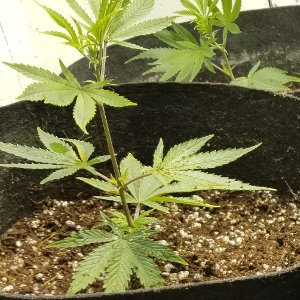How to choose the best growing mediums for marijuana plants
If you’re looking to find the best growing mediums for marijuana plants, there are several options: soil, soiless mediums such as coco coir, and hydroponics. All of these mediums can produce great weed plants. We can help you select the best marijuana growing mediums for your needs and budget.
First time growers will find that setups with soil and coco coir are less expensive than hydroponics. Coco and hydro systems provide a nutrient solution directly to plants’ roots, resulting in fast, vigorous growth. We grow in coco and have had great results from even the first grow. Coco combines the benefits of hydroponic feeding with inexpensive setup costs and is a good option for beginners.
Plants in soil absorb nutrients from the soil itself, so the growth isn’t as fast. Soil grows allow you to grow organic marijuana plants, since organic fertilizers can be slowly released within soil. Coco and hydroponics aren’t organic methods.
While the idea of organic is important to some weed growers, others prefer the fast growth and bud production attained by hydro feeding. Keep in mind that just because something is organic doesn’t mean it’s good for you; arsenic is organic and you wouldn’t want to ingest that!
Coco Coir

Coco coir (the shredded husks of coconuts) uses a nutrient solution so it’s technically a hydroponic method of growing marijuana. It’s one of the best growing mediums for marijuana plants for beginning growers.
Coco is placed in containers (cloth bags, plastic containers, etc.) and watered similar to soil. It’s important to water more than can be absorbed, this runoff washes away excess nutrient salts. The frequent waterings provide oxygen as well as the required nutrients.
Because coco allows for plants to quickly access the nutrients, you have to ensure your nutrient solution is properly PH’d within a range of 5.5-6.5 and that your ratio of nutrients isn’t too strong. If your PPM or EC is too high, excess salts in the coco will lead to nutrient burn on your plants. It’s possible to flush the coco with clean PH’d water if this happens to reduce these salts.
Coco coir is an inexpensive way to grow marijuana. A bag of good coco runs about $20 and can fill four 5-gallon containers. You can also buy coco in compressed bricks that you’ll have to hydrate, these are cheaper but are more work. Mixing coco with 30-40% perlite improves drainage and is recommended. Adding stones to bottom of felt bags will allow for drainage as well.
Coco isn’t as prone to insect infestation as soil, but you may still have to battle fungus gnats if you water too frequently and don’t let the top layer dry out between waterings.
Soil
Growing weed in soil is an easy, inexpensive choice for many growers who are already familiar with growing other plants in soil. Outdoor growers have tremendous success in soil using the sun. It’s possible to recreate this indoors with high intensity lighting.
Indoor soil grows are perfect if you’re looking to grow organic marijuana. There are a lot of different organic fertilizer and soil amendment options that are readily available. Choose fertilizers meant specifically for marijuana. Avoid Miracle-Gro, fertilizers such as this will harm your plants.
Never use soil from your backyard or compost pile for indoor grows, you’ll likely introduce lots of unwanted pests that will harm your plants. Soil you get for growing weed is typically a mix of ingredients. There are lots of options available for soil mixes, choose a quality brand of bagged soil from your local hydro shop along with necessary amendments and you should be all set. Again, do not use Miracle Gro premixed soil for marijuana or you will be disappointed in the results.
Soil grows can use 5 gallon buckets, cloth bags, or you can even reuse spare plastic plant containers you may have laying around. Be sure to clean and sterilize the latter to avoid unwanted pests or problems.
Hydroponics
Hydroponics uses a liquid nutrient solution to provide nutrition directly to plant roots. It provides for fast plant growth and the ability to control the amount of nutrients the plants will receive. It is commonly utilized by commercial growers looking to use the best growing mediums for marijuana plant growth.
There are several different hyrdroponics methods for growing marijuana. Below we cover some of the more common methods that growers use. Each has its benefits and drawbacks, so be sure to fully understand what is involved before you invest in hydroponics equipment.
Deep-water culture (DWC)
Deep water culture hydroponics is a relatively simple method to grow marijuana. DWC setups can be as simple as suspending a plant in a 5-gallon bucket and using an air pump with an air stone (similar to a fishtank) to add oxygen to the nutrient solution.
Growing marijuana in DWC leads to very fast root growth. You’ll be able to lift the plant out of the bucket and directly observe how the roots are doing, a big advantage over coco or soil. If you’re growing just a few plants, DWC is a great choice. It’s a bit more work to maintain than other more automated hyrdro method since each bucket needs to be maintained individually, so it’s not a good option for large scale commercial grows.
DWC equipment is inexpensive, so it’s a great entry point into growing hydroponically. Learn more about how to grow in Deep Water Culture (DWC) systems.
Nutrient film technique (NFT)
Nutrient film technique (NFT) is a hydroponic technique that uses a shallow stream of liquid nutrient solution that is continually re-circulated past the bare roots of plants in a watertight channel beneath the plants.
The system comprises of plants suspended above the channel. A water pump pushes water to the top of the channel and gravity then feeds it to run past the roots into a reservoir containing an air stone to keep the nutrient solution oxygen.
NFT systems can be used by small home growers as well as large industrial marijuana grows. It’s a relatively simply method, so while commercially available NFT systems are available it’s also possible to construct your own system. It can be designed to meet growing areas of all sizes.
Be aware that this type of system requires electricity to circulate the nutrients, so any extended power outage would be catastrophic to your plants. You’ll need to dial in your nutrients to ensure proper plant growth. Monitor plants closely for signs of problems, which can be quickly corrected if caught early. Once dialed in, the systems are relatively easy to maintain.
Ebb-and-flow (Flood and Drain)
Ebb and flow hydroponics systems flood the plant roots 4-6 times per day and then drain it back into a reservoir. Ebb and flow systems are a good option for intermediate growers.
They’re relatively simple systems to operate. Plants are placed in a grow medium that anchors the roots such as gravel, clay pellets, or lava rocks. The plants are kept in a grow tray on a slightly angled grow table that is filled by a pump on a timer with nutrient solution, and then drained.
An air stone is needed to keep the nutrient solution oxygenated in the reservoir. Once flooded, the plants are essentially in Deep Water Culture mode, although they aren’t still being supplied with fresh oxygen as in DWC since the air stone is only in the reservoir.
Ebb and flow systems are great for lots of small plants in a “Sea of Green” setup. However, most home growers are limited in the number of plants they can legally grow, so make sure to check with local laws before getting started. This method also works well in square grow tents since grow trays are available in sizes that fit within 4×4 and 5×5 tents easily.
Ebb and flow systems use a single source of liquid nutrients for all plants, so any contamination or problems will affect the entire crop. Any issues with power outages or clogged waterlines will cause quick problems since roots will stop receiving nutrition and oxygen. You’ll need to monitor such systems closely. Be careful about buying overly inexpensive ebb-and-flow systems, cheap parts can jeopardize the entire garden.
Run to waste
Run to waste hydroponics differs from other hydro methods because the runoff solution is discarded rather than recirculated. Plants are held in mediums such as coco, rockwool, or soil, and an automated pump on a timer disperses the nutrients.
This method isn’t widely used in commercial applications due to the contamination of the runoff water. But it can be great for small growers looking to automate the watering of marijuana plants in coco coir.
Feedings are less frequent than other hydro methods. One advantage of run to waste is that the grow medium absorbs the liquid solution and keeps it available for the roots, protecting you in the case of power outages. Water tends to flow where the root density is low, so you need to make sure the roots are getting watered evenly. You’ll need to flush clean PH’d water to remove excess nutrient salts.
Because the nutrients aren’t recirculated, problems such as root disease aren’t cross-contaminated to other plants. This is another advantage of run to waste over other hydro systems.
Summary
There are lots of different ways you can grow marijuana, so it’s hard to say that any one method would be the best growing mediums for marijuana plants.
Soil is a good choice because it is forgiving and somewhat familiar to most beginning growers. Coco provides the benefits of hydroponic nutrient solutions with a somewhat forgiving medium. Other hydro methods can also produce great results but they can have a higher startup cost and drawbacks.




















